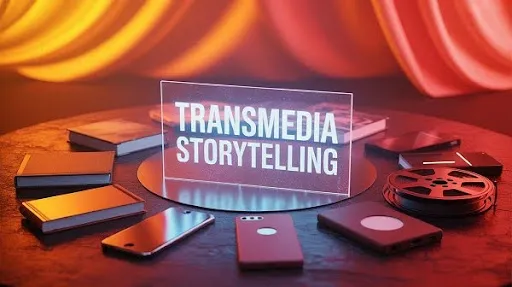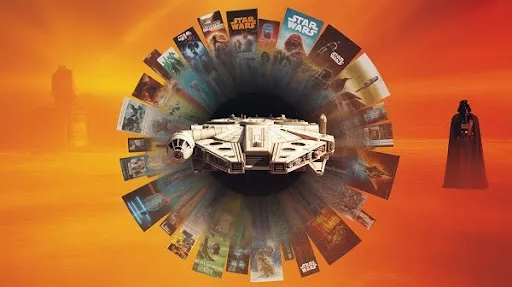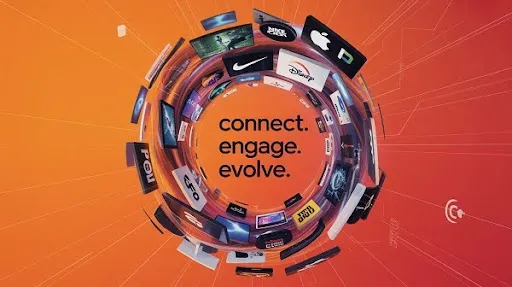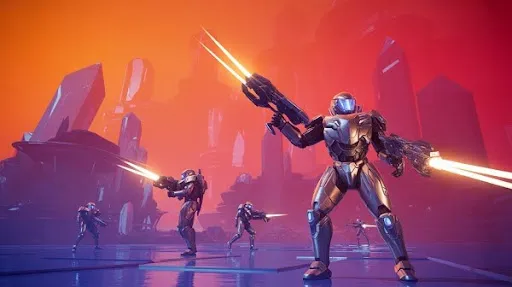Stories used to have just one home. A book. A stage. A film reel. You’d finish it, close the cover, or watch the credits roll, and that was the end. Today, that’s rarely the case. Stories break out of their boxes.
They flood screens big and small, bleed into video games, animate comics, launch shiny apps, chatter in podcasts, and even photobomb selfies as those weird AR filters that change your hair.
When folks drop the phrase transmedia storytelling, that’s the vision: one flickering tale leaping from one screen to another, and somehow the flame never dims.
It isn’t some quick fad. For decades, this quietly unifying technique has shaped our entertainment routines and the way companies speak to us, from the galaxy of Star Wars to the sword-and-sorcery of The Witcher, from the interconnected energy of Marvel to the gentle nudges of smart marketing.
You’ve bumped into it countless times—probably while scrolling, clicking, or simply daydreaming—because it likes to blend in.
But before diving into examples, let’s ground ourselves in the basics.
What is Transmedia Storytelling?
At its heart, the idea is simple: one story wanders onto multiple canvases, and each canvas whispers something fresh that the last canvas hinted at. Imagine the main tale as a vertebra; every short film, tweet, podcast, or VR mission is another rib, cozying up to a new angle. No rib simply hollers the main bone again; it flexes in a subtler shade of the same curve.
Take a novel that becomes a video game. The game doesn’t just copy the book word-for-word. It introduces fresh characters, side missions, or hidden backstories. That’s what makes it transmedia instead of just a script translated into another format.
So, what is transmedia? It’s not simply hopping between mediums. It’s building an interconnected transmedia experience where fans get rewarded the more they explore.
Fact: According to one study on transmedia journalism, three-quarters of participants admitted that interactive platforms like podcasts, social media, and videos increased their engagement.
What is the Difference Between a Traditional Story and a Transmedia Story?
A traditional story usually gives you everything in one shot: a beginning, a middle, and an end. When you finish the book or the movie, you’ve got the complete arc. It could be a product of amazing storytelling done for a comic book or a well-developed 3D animation project.
The entire transmedia fabrication is less a novel to read cover to cover and more a tapestry of pieces of varying colors magnetically tucked into separate corners. One character’s motive clicks inside a collectible card; the hero’s voice echoes inside an augmented-focused mission—each bobbing puzzle piece granting you permission to rotate the observed assembly.
Collected, the whole pattern snaps into clarity. Miss one, and you’ll still enjoy the ride. Collect them all, and you’ll discover a richer universe.
- Traditional story → one container, one full narrative.
- Transmedia story → scattered parts that link into something larger.
That’s why Marvel watchers never-night-in London: they yank movie credits and slide into comics, lured by the glimmer of a footnote. They toast Tony’s quips in games, groove to Howard the Duck in podcasts, and revel in a multiverse of vector emojis. Each platform adds something fresh.
Why Transmedia Narratives Work
Audiences don’t just want to know what happened. They crave the “why” and the “what if.” A single film might show the main events, but fans want to see what characters were doing off-screen or what would change if a choice went differently.
That’s what makes transmedia narratives so powerful. They let people go deeper on their own terms.
When a transmedia story works well:
- Fans pick their own level of involvement.
- Each piece feels like a complete story.
- The whole thing connects into something bigger than any one part.
That freedom keeps people hooked.
Key Ingredients of a Strong Transmedia Experience
Every successful project is built on three essentials:
1. Story – The Backbone
Without a clear backbone, the whole thing feels scattered. The core narrative sets the tone and rules. The side plots, spin-offs, and extensions can add layers, but the spine keeps everything consistent.
2. Technology – The Delivery
Here’s where different transmedia technologies come in. Movies, comics, games, AR apps, VR experiences, or even 2D animated shorts. Each format brings out a strength of its own. A show can capture emotion. A game lets fans step inside the action.
3. Audience – The Fuel
Audiences aren’t just watching anymore. They keep the story alive. Some stick with the main entry, while others dive into every spin-off. Both groups get satisfaction, but the ones who go deeper feel rewarded. That flexibility is what makes a transmedia experience thrive.
Brand Character and Transmedia Storytelling
This isn’t just for Hollywood. Brands are using it too. A brand character can act as the anchor across platforms. The character flips from billboard to billboard, and suddenly they’re the one scrolling selfies with viral taglines, popping up in low-fi games, flirting in quick social ads, dunking lightsabers at viral events.
That shift turns a logo into something fans connect with. It’s not just “buy this.” It’s “be part of this story.”
Take animated mascots. They’re no longer stuck in TV spots. Through brand character and transmedia storytelling, they appear in short films, interactive campaigns, AR filters, or even VR experiences. It stops being advertising and becomes something people willingly engage in.
Different Transmedia Story Elements You’ll Notice
Transmedia doesn’t have one formula. It can show up in different ways, like:
- Side character spin-offs exploring untold backstories.
- Alternate “what if” timelines.
- Games or interactive content where fans help shape outcomes.
- Cross-platform tie-ins where books feed into shows or comics add missing chapters.
These different transmedia story elements expand the narrative without breaking the main spine.
Transmedia Storytelling Examples You Already Know
Some of the most world-renowned transmedia stories prove just how effective this method can be:
- Star Wars – Beyond the original movies, there are animated series, novels, video games, comics, and even theme park rides. Each adds depth to the galaxy.
- Harry Potter – What started with seven books grew into films, stage plays, spin-off movies, games, and a theme park.
- Marvel and DC Comics – Probably the most famous examples. Stories play out in comics, TV, movies, and games, but still tie back into shared universes.
- The Witcher – A standout case study. What began as novels spread into comics, a blockbuster game series, and now a hit Netflix show.
These aren’t just adaptations. Each entry brings something new, which is why fans keep exploring every corner.
How Different Transmedia Technologies Expand a Story
When people hear “transmedia technologies,” their mind often jumps straight to flashy VR goggles or some new app. But honestly, it’s way bigger than that. Pretty much any medium that can carry a part of the story counts. The trick isn’t the tech—it’s how each piece connects back to the bigger picture.
Here are a few of the usual suspects you’ll see in a transmedia mix:
- Film & TV – lays down the big cinematic beats.
- Books & Comics – dig deeper into backstories and side plots.
- Games – flip the script and let fans play inside the world.
- Web & Social Platforms – bonus layers: behind-the-scenes clips, ARGs, fan debates.
- Theme Parks – a chance to physically step into the story.
- AR & VR – drop-you-in-the-middle experiences you can’t get on a screen.
The real magic? It’s in the connections. A movie might introduce a character, the comic might fill in their backstory, and a mobile game could let fans live a day in their shoes. Each one feels different, but together, it’s one expanding story.
Why Brands Are Jumping In
Entertainment has been doing this for decades, but now brands are catching up. People don’t want a billboard yelling at them anymore. They want to feel part of something.
Brand Characters in the Mix
Think about mascots, animated brand figures, even sports stars tied to a product. When they live across commercials, web series, games, or interactive campaigns, they stop being “just ads.” They turn into ongoing characters people actually follow.
And that changes the game. No ads, just invitations. The more you slide between platforms, the thicker the loyalty glues itself to the character’s forehead. Swipe, stream, ouija-player—repeat.
What Makes a Transmedia Experience Stick?
Not every attempt works. The ones that do usually share a few traits:
- Consistency – The world feels the same wherever you enter it.
- Something new every time – No one wants the same story copied and pasted into another format.
- Choice – You can stay casual or go all-in. Both paths still feel rewarding.
Miss one of those, and the whole thing falls flat. Nail them, and fans keep coming back for more.
Transmedia Storytelling Beyond Entertainment
It’s not just about wizarding worlds or superheroes. Brands are doing it too:
- Nike – builds athlete-driven narratives across ads, apps, films, and challenges.
- Coca-Cola – creates story-worlds where brand characters exist beyond commercials.
- LEGO – more than toys: movies, games, parks, and apps all feed the same core idea—creativity.
These show that transmedia storytelling isn’t locked into Hollywood. It’s just as powerful for building brand experiences people actually enjoy.
Frequently Asked Questions
What’s transmedia storytelling in plain English?
Telling one story across different formats, with each adding something new.
How’s it different from a traditional story?
Traditional = one medium, one complete arc.
Transmedia = lots of connected pieces that expand the whole.
Can brands use it?
Definitely. With the right character or campaign, transmedia can make people feel connected to a brand in ways ads alone never could.
Famous examples?
Star Wars trick-or-treats over books, films, games, memes, and more. Harry Potter chandelier-chases different cylinders. Marvel lands missiles of multitudes. DC lights up reflections of strangers staring back. The Witcher, a player’s bottle, banners you into one inky bar after another.
Do you need advanced tech to pull it off?
Not at all. A comic and a podcast can be just as effective as VR. What matters is how they connect.
Why Transmedia Matters Now More Than Ever
Look at how people consume content today—they’re streaming, scrolling, binging, gaming, all at the same time. A transmedia approach fits perfectly into that world. It doesn’t force people into one channel. Instead, it rewards them for exploring across many.
That’s why both studios and brands are doubling down. It’s not about one platform—it’s about the story living everywhere the audience already is.
Final Word
At the heart, it’s a matter of hospitality: one head of story is invited into three rooms, and each room slides open a secret drawer. The reel murmurs the beats, the novel thickens the motivations, the event pattern scrawls lore in the darkness of a museum. Together, the rooms speak as one storyteller, but each member retains a fresh accent.
For entertainment, that means fan bases that never feel “done.” For brands, it means ads that don’t feel like ads anymore.
Now, if your charge is leaving an echo inside minds and a warm ache inside chests, the single-installation mindset is the first hurdle to leap. That’s the request we distill at Prolific Studio, one of the best animation studios in Seattle: stitching a seedling of an idea into a sinuous storyscape that continues to beckon home.
Related articles:










